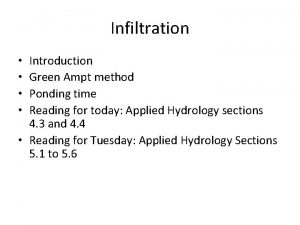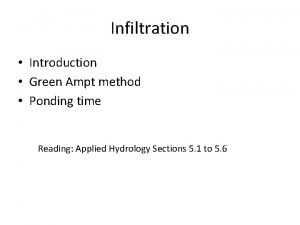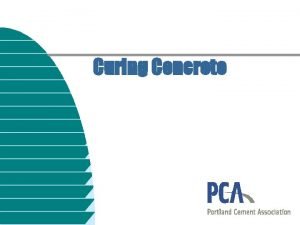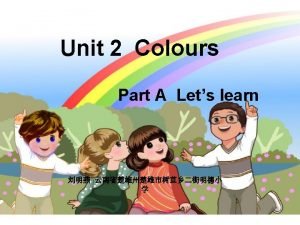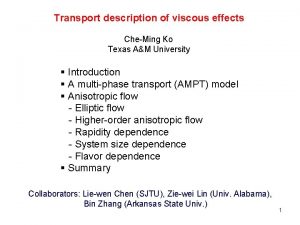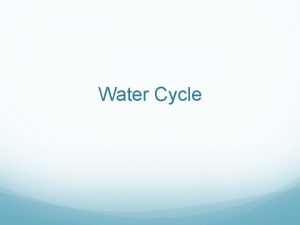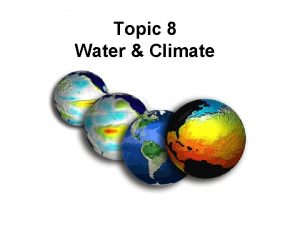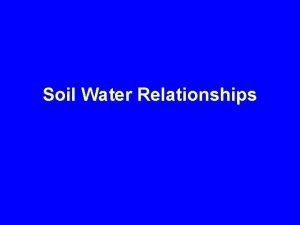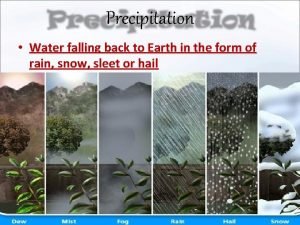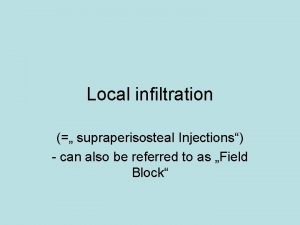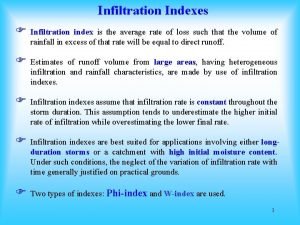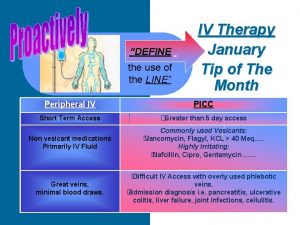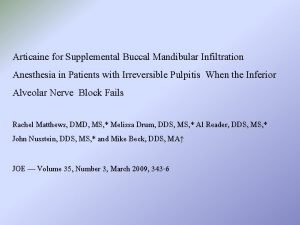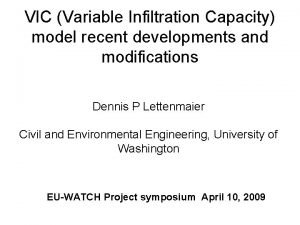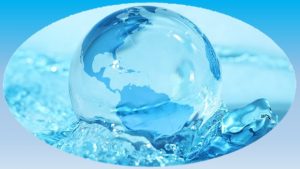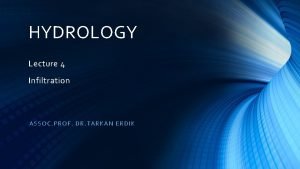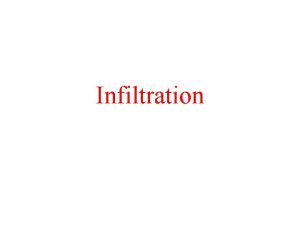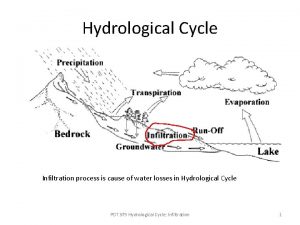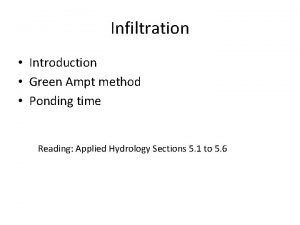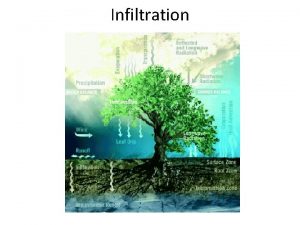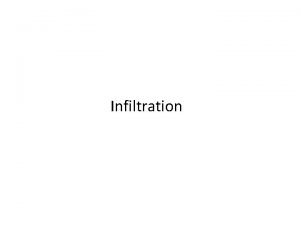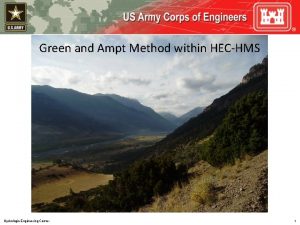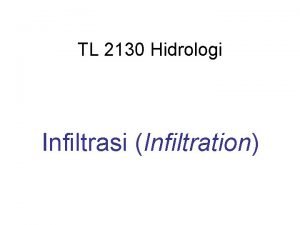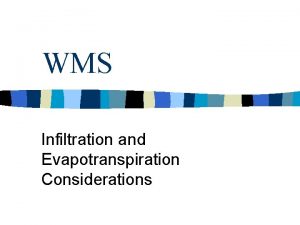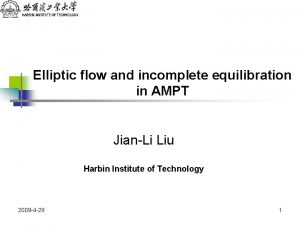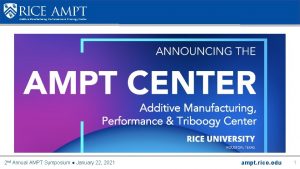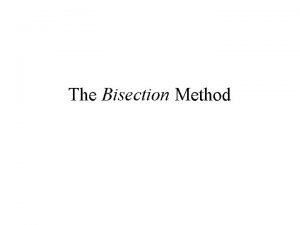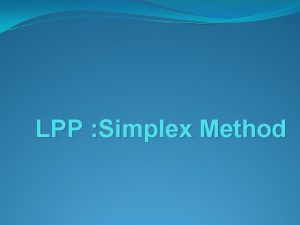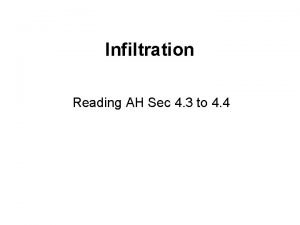Infiltration Introduction Green Ampt method Ponding time Reading





















- Slides: 21

Infiltration • Introduction • Green Ampt method • Ponding time Reading: Applied Hydrology Sections 5. 1 to 5. 6

Infiltration • General – Process of water penetrating from ground into soil – Factors affecting • Condition of soil surface, vegetative cover, soil properties, hydraulic conductivity, antecedent soil moisture – Four zones • Saturated, transmission, wetting, and wetting front q Saturation Zone Transition Zone Transmission Zone Wetting Front depth

Infiltration • Infiltration rate, f(t) – Rate at which water enters the soil at the surface (in/hr or cm/hr) • Cumulative infiltration, F(t) – Accumulated depth of water infiltrating during given time period f, F F f t

Infiltrometers Single Ring Double Ring http: //en. wikipedia. org/wiki/Infiltrometer

Infiltration Methods • Horton and Phillips – Infiltration models developed as approximate solutions of an exact theory (Richard’s Equation) • Green – Ampt – Infiltration model developed from an approximate theory to an exact solution

Green-Ampt Assumptions = increase in moisture content as wetting front passes = Suction head at “sharp” wetting front = Wetted depth Ponded Water Ground Surface Wetted Zone Conductivity, K Wetting Front = Conductivity in wetted zone = Depth of water ponding on surface (small) Dry Soil

Green-Ampt Soil Water Variables = moisture content (volume of water/total volume of soil) = initial moisture content of dry soil before infiltration happens Ground Surface Wetted Zone = increase in moisture content as wetting front passes = residual water content of very dry soil Wetting Front = effective porosity = porosity Dry Soil

Green-Ampt Parameters (Data from Table 4. 3. 1) Texture Residual Porosity n Porosity ϴr Effective Suction Head Porosity ϴe ψ (cm) Conductivity K (cm/hr) Sand 0. 437 0. 020 0. 417 4. 95 11. 78 Loamy Sand 0. 437 0. 036 0. 401 6. 13 2. 99 Sandy Loam 0. 453 0. 041 0. 412 11. 01 1. 09 Loam 0. 463 0. 029 0. 434 8. 89 0. 34 Silt Loam 0. 501 0. 015 0. 486 16. 68 0. 65 Sandy Clay Loam 0. 398 0. 068 0. 330 21. 85 0. 15 Clay Loam 0. 464 0. 155 0. 309 20. 88 0. 10 Silty Clay Loam 0. 471 0. 039 0. 432 27. 30 0. 10 Sandy Clay 0. 430 0. 109 0. 321 23. 90 0. 06 Silty Clay 0. 470 0. 047 0. 423 29. 22 0. 05 Clay 0. 475 0. 090 0. 385 31. 63 0. 03

Green-Ampt Porosity (Data from Table 4. 3. 1) 0. 45 0. 09 Clay Residual Porosity ϴr Silty Clay Effective Porosity ϴe Sandy Clay Silty Clay Loam • Total porosity ~ 0. 45 • Clay soils retain water in ~ 20% of voids when dry • Other soils retain water in ~ 6% of voids when dry Sandy Clay Loam Silt Loam Sandy Loamy Sand 0. 03 0. 1 0. 2 0. 3 0. 4 0. 5

Conductivity and Suction Head (Data from Table 4. 3. 1) 100. 00 Conductivity, K (cm/hr) Sand 10. 00 Loamy Sandy Loam 1. 00 0 0. 10 0. 01 5 Suction Head, ψ (cm) Silt Loam 10 15 20 25 30 35 Loam Sandy Clay Loam Silty Clay Sandy Clay

Green – Ampt Infiltration Ponded Water Ground Surface Wetted Zone Wetting Front Dry Soil

Green – Ampt Infiltration (Cont. ) Ground Surface Wetted Zone Wetting Front • Apply finite difference to the derivative, between – Ground surface – Wetting front Dry Soil

Green – Ampt Infiltration (Cont. ) f, F Use and integrate over time, gives F f t Nonlinear equation, requiring iterative solution

Initial Effective Saturation Initial effective saturation 0 ≤ Se ≤ 1 Effective porosity

Example • Determine the infiltration rate and the cumulative infiltration after 1 hour on a clay loam soil with initial effective saturation of 30%. Assume water is ponded instantaneously on the surface • Parameters: Texture Clay Loam Residual Porosity n Porosity ϴr 0. 464 0. 155 Effective Suction Head Porosity ϴe ψ (cm) 0. 309 20. 88 Conductivity K (cm/hr) 0. 10

Solution Use Excel Solver

Ponding time • Elapsed time between the time rainfall begins and the time water begins to pond on the soil surface (tp)

• Up to the time of ponding, all rainfall has infiltrated (i = rainfall rate) Infiltration rate, f Ponding Time Potential Infiltration Rainfall Cumulative Infiltration, F Actual Infiltration Accumulated Rainfall Time Infiltration Time

Example • Clay Loam soil, 30% effective saturation, rainfall 1 cm/hr intensity • What is the ponding time, and cumulative infiltration at ponding? • How long does it take to infiltrate 2 cm of water? • What is the infiltration rate at that time?

Infiltration after ponding has occured •

Solution
 Green ampt method formula
Green ampt method formula Ampt time zone
Ampt time zone Ponding and immersion
Ponding and immersion Yellow light
Yellow light Ampt guard
Ampt guard Pre reading while reading and post reading activities
Pre reading while reading and post reading activities Surface runoff meaning
Surface runoff meaning Topic 8 water and climate
Topic 8 water and climate Soil infiltration rate
Soil infiltration rate Infiltration vs percolation
Infiltration vs percolation Buccal infiltration
Buccal infiltration Infiltration process
Infiltration process Scs curve number
Scs curve number Iv infiltration stages
Iv infiltration stages Infiltration def water cycle
Infiltration def water cycle Buccal infiltration
Buccal infiltration Variable infiltration capacity
Variable infiltration capacity Infiltration definition geography
Infiltration definition geography Infiltration is
Infiltration is Infiltration water cycle
Infiltration water cycle Infiltration capacity of soil depends upon *
Infiltration capacity of soil depends upon * Infiltration curve
Infiltration curve
